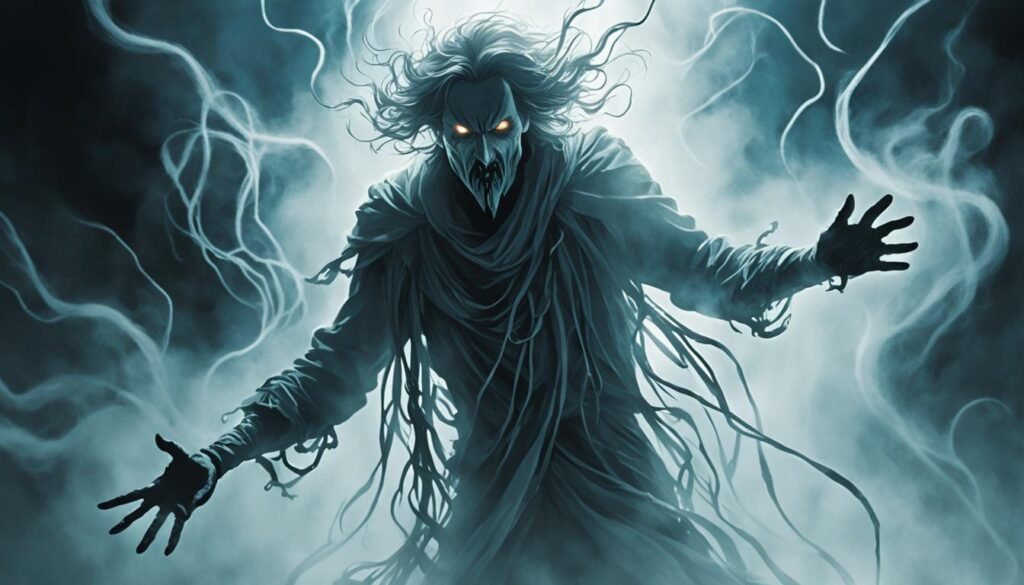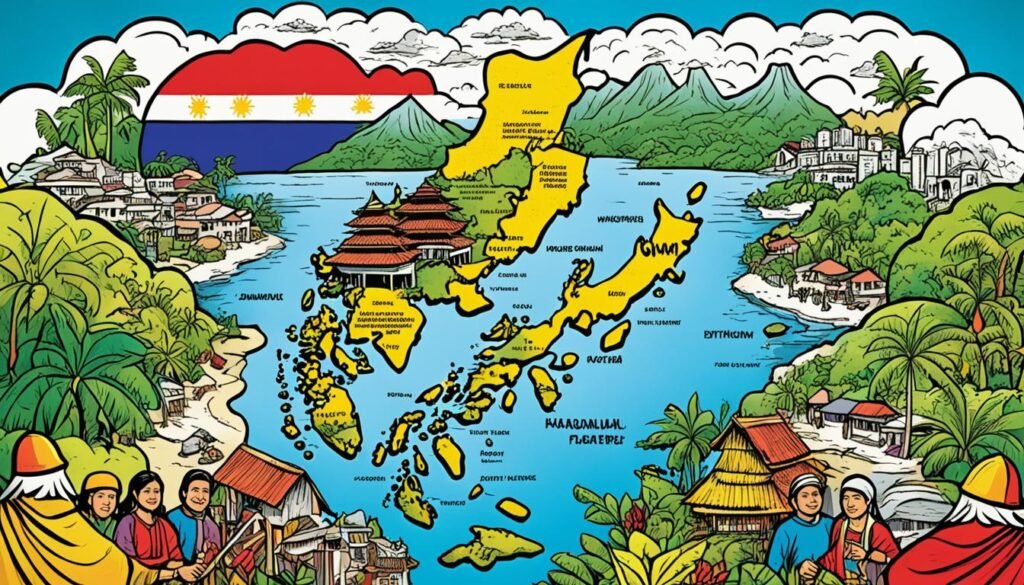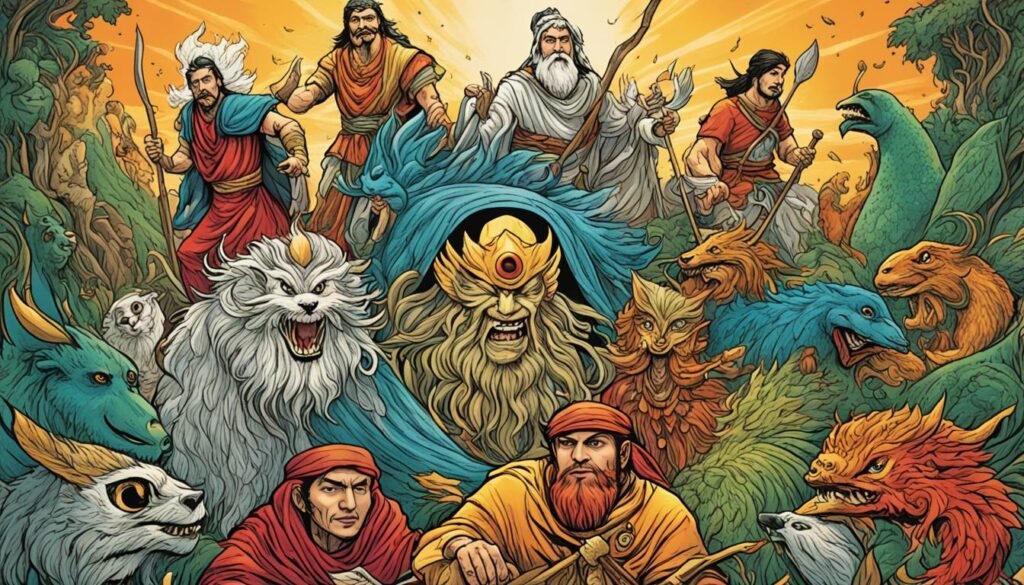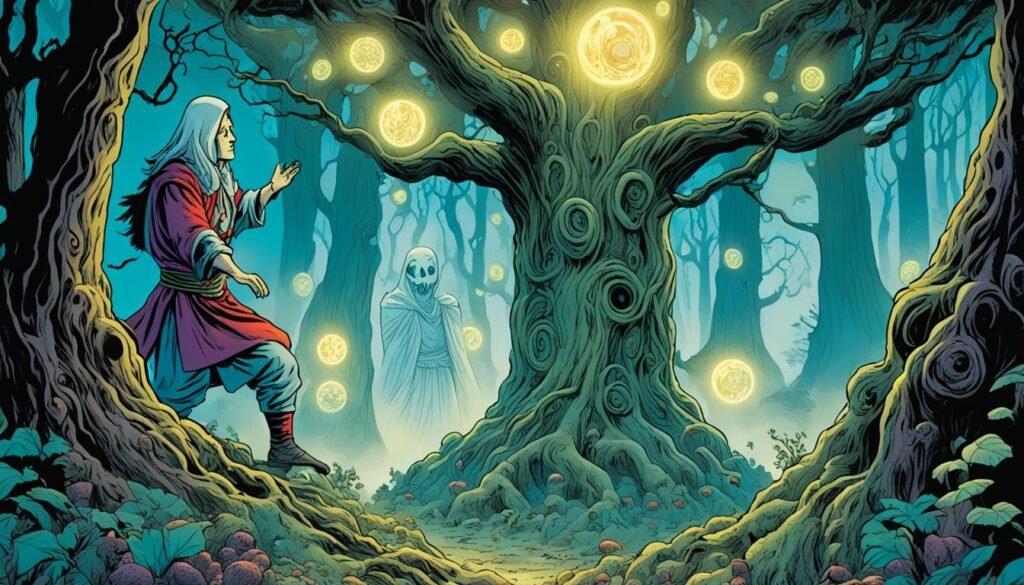In the heart of Manila, a dimly lit street was filled with eerie quiet. Shadows grew longer as a young woman made her way home. She heard the sound of leaves rustling behind her and looked back.
A ghostly figure, pale and drifting, moved among the trees. A shiver went down the woman’s spine. She walked faster, feeling uneasy about what she saw.
The multo are spirits that play a big part in Philippine folklore. They have long been a source of stories for the people of the Philippines. These supernatural beings are known for their different forms and the myths they are a part of.
This article looks into the world of the multo. We will talk about where they come from, the kinds there are, and the stories about them. Plus, we will cover the rituals and what people believe about them. Our goal is to help you understand the Philippine folklore better and see why it still matters today.
Key Takeaways
- The multo are a central part of the rich tapestry of Philippine supernatural beliefs and folklore.
- Multo refer to the wandering spirits or ghosts that continue to captivate imaginations across generations.
- This article will explore the origins, types, legends, rituals, and cultural significance of the multo in the Philippines.
- Understanding the multo is crucial to appreciating the depth and complexity of Philippine folklore and its continued relevance.
- The article aims to provide readers with a deeper understanding of this integral aspect of Philippine culture.
Introduction to Philippine Folklore
Philippine folklore is a treasure trove of stories and myths passed from one generation to another. These tales often feature spirits, ghosts, and strange entities. They are key parts of the cultural heritage of the Philippines.
It includes creatures like aswangs, tikbalangs, and the more elegant diwatas and engkantos. The stories of multo, or ghosts, stand out, showing a wide range of stories and beliefs from different regions.
Learning about the multo helps us understand the complexity of Philippine beliefs. These stories offer a glimpse into how the supernatural is viewed in the country.
Multo: Meaning and Origins
The word “multo” comes from the Tagalog language. This language is the root of the Filipino national language. In Tagalog, “multo” means ghost or spirit that might appear or haunt people. It is linked to “bangungot,” which is about nightmares or beings that cause them.
Multo in Tagalog Language
Philippines’ deep beliefs in ghosts and spirits come from a mix of its own and Spanish traditions. Spanish colonizers arrived in the 16th century. They brought their Catholic religion and ways, mixing them with local tales.
Influence of Spanish Colonization
The Spanish added Catholic practices to the local beliefs. Many ghost stories mix Philippine and Spanish beliefs. For example, the “alma en pena,” or the wandering soul, has similarities to the multo. This mix shaped the diverse ghost stories of the Philippines.

Types of Multo
In Philippine folklore, the aswang is one of the scariest multo types. It can change shape and sucks blood. People believe the aswang or its victims’ spirits can become multo. They haunt others, just like the aswang would, and feed on blood or organs. Stories of these multo are common in areas like the Visayas and Bicol.
Nature Spirits and Fairies
Not all multo are scary. Some are friendly and linked to nature. Known as “engkantos” or “diwatas,” they stay in places like forests and mountains. They protect these areas and help keep nature in balance. These multo are seen as beautiful and magical. They teach the lesson of respecting nature to live in peace with them.
Vengeful Souls
There are also multo in Philippine tales with grudges or unfinished tasks. These multo’s restless souls seek revenge. They might haunt the spots of their death or target their wrongdoers. Stories about them show the need to show respect for the departed. Not doing so might bring their vengeful revisit.
Encounters with Multo
In the Philippines, many people say they’ve met or seen a multo. These are supernatural beings. People tell stories of seeing them, feeling their touch, or even being taken over by them.
A multo’s presence is often linked to strange noises and strange lights or shadows. You might also feel a scary coldness if they are near you. People react in different ways. Some perform rituals to protect themselves, while others try to pretend nothing happened.
These stories show how deeply the belief in multo is in the Filipino culture. For example, even though about 3,000 people officially live in the Manila North Cemetery, some say there could be around 56,000. This makes the cemetery a prime spot for multo sightings. Local kids talk about being bullied and called “multo” or “zombies”. This bullying sometimes even forces them to quit school.
Children from the cemetery community don’t always have it easy. To make money, they collect candle wax and sell it. This shows the tough mix of social issues and the strong belief in multo. To make ends meet, children in the cemetery community often collect melted wax from candles and sell it to recycling centers.

Multo Legends and Stories
One famous story from the Philippines is about the multo of Baao. Baao is a place in the Camarines Sur province. It’s said to be haunted by the spirits of those who died, especially in the old buildings. The ghosts can appear in many forms or create strange sounds. This legend both fascinates and scares people, locals, and tourists. It shows how these stories influence the culture and thoughts of the Philippines.
The Amalanhig of Visayas
In the Visayas region, the story of the amalanhig is known. These are like vampires that cannot fly. They come back to life to suck blood. The amalanhig have stiff legs and a pointed tongue. They use it to take life from people. To keep them away, stories say people can climb crooked trees or jump in water. This tale shows the deep fears and beliefs about death in Philippine culture.
Rituals and Protection against Multo
In the Philippines, people use different rituals and actions to stop multo. A common way is by using holy water and symbols like crucifixes or blessed items.
Holy Water and Religious Symbols
Catholicism in the Philippines taught that holy things can cleanse or protect. Families keep holy water at home or use it to bless their property. This mixes traditional Filipino beliefs with Catholic faith, showing the country’s diverse supernatural views.
Traditional Chants and Prayers
Philipino folklore also involves using chants and prayers to handle multo. People say special verses or call on spirits to keep safe or chase away unwanted spirits. The exact prayers and rituals change by region and family.
Some families keep their unique protective rituals. These beliefs show a strong faith in the supernatural and honoring the past. They believe this connects them to their ancestors and spirits for protection.

Multo in Filipino Culture and Arts
The multo and supernatural beings in Filipino stories have inspired many. They’re in classic tales, legends, and modern fiction works. These characters are a big part of the country’s literary history.
Folklore Literature
One famous author, Nick Joaquin, wrote stories with multo and other ghosts. These tales have been studied and put into books. This keeps the stories alive for more people to enjoy.
Movies and TV Shows
Not just in books, multo appear in films and shows too. They’re in horror movies and shows that make people scared and interested. This use helps keep the stories popular.
Films like “Shake, Rattle & Roll” and “Eerie” are great examples. TV series such as “Majika” and “Mara” talk about multo and other Filipino creatures. They make these beings known to many.
Regional Variations of Multo Beliefs
The beliefs about multo in the Philippines change from one region to another. This shows the many cultures and languages in the country. In Ilocos, for instance, multo often link to the kapre. This is a giant creature with eyes that shine like fire. On the other hand, in the Visayas, the amalanhig is a popular kind of multo.
Bicol has a belief about the anduduno multo, which hunts the sick and dying. In Mindanao, however, the agta features. This is a huge, dark, human-like creature who walks the forests. These tales of multo from different regions show how rich and varied Philippine supernatural stories are. They have grown and changed to fit each area’s unique culture and environment.
Learning about these different stories is important if we want to understand the wide world of multo beliefs in the Philippines.

Skepticism and Rational Explanations
Many in the Philippines believe in multo, but some take a different view. They look at these ghost stories with doubt and logic. They offer reasons like making mistakes, being scared for other reasons, or things just happen naturally.
Strange noises or sights could just be from the natural world. And the fear could come from how we feel inside. Some people think the ghost stories tell us about real problems the world faces, not just spooky tales.
This way of thinking shows an ongoing conversation. People are always trying to understand what ghosts mean in Philippine culture and stories.
Parallels in Other Cultural Beliefs
In Philippine folklore, we have the multo. Other Asian cultures have similar ideas. For example, in Japan, there’s the “muenbotoke,” souls that died without family. They’re like the multo, restless and sometimes harmful spirits. In China, there’s the idea of a “hungry ghost.” This reflects the way some multo are believed to prey on the living.
These connections show common themes in Asian supernatural beliefs. They might come from shared history or the spread of ideas. Learning about these links helps us understand the bigger picture of the multo and Philippine folklore.
Western Ghost Stories
Philippine folklore includes the multo, and Western stories have their own ghosts. Some common elements are the spirits that can’t rest, places haunted by the dead, and ghosts interacting with us. Both cultures share tales involving spirits seeking justice or revenge.
These shared ideas hint at universal themes in supernatural beliefs. They point to our collective human experiences. Looking at these parallels helps us see the multo in a worldwide context of our interest in the supernatural.

Preserving Philippine Folklore
There is a big change in the Philippines due to modernization and globalization. People are worried about losing their old stories and beliefs, especially about the multo. So, many are working hard to keep these tales alive for younger Filipinos.
Efforts include making anthologies, online archives, and teaching programs. The International Journal of Language and Literary Studies has shared studies about keeping Philippine myths and stories. They talk about why these tales are so important.
There’s also a need to make old myths and spooky stories fit today’s world. They show up in movies, TV shows, and books. This mix of old and new helps Philippine myths stay interesting and important in the culture.
| Ethnolinguistic Groups in the Philippines | Percentage |
|---|---|
| Cordillera Administrative Region (CAR) | 33% |
| Mindanao | 61% |
| Visayas | Remaining percentage |
The Philippines has more than 110 different groups, each with its special customs and stories. This makes Filipino folklore very rich. Keeping these old stories is key to keeping the Philippines’ culture and history alive. It’s all part of the country’s identity.

Conclusion
The multo, known as wandering souls in Philippine folklore, are a key part of the country’s supernatural tales. They come from Tagalog culture and language. With many stories about them, the multo have deeply entered the minds of the Filipino people.
Stories, rituals, and art show their impact on the Philippines. Even as the country changes with modern times, keeping these tales alive matters. It helps preserve the country’s unique identity and past.
This article explored the deep meaning of the multo in Philippine culture. Even today, these spirits influence the art and stories of the Philippines. They continue to fascinate and bring people together. The multo show the strength and lasting power of Filipino traditions.

